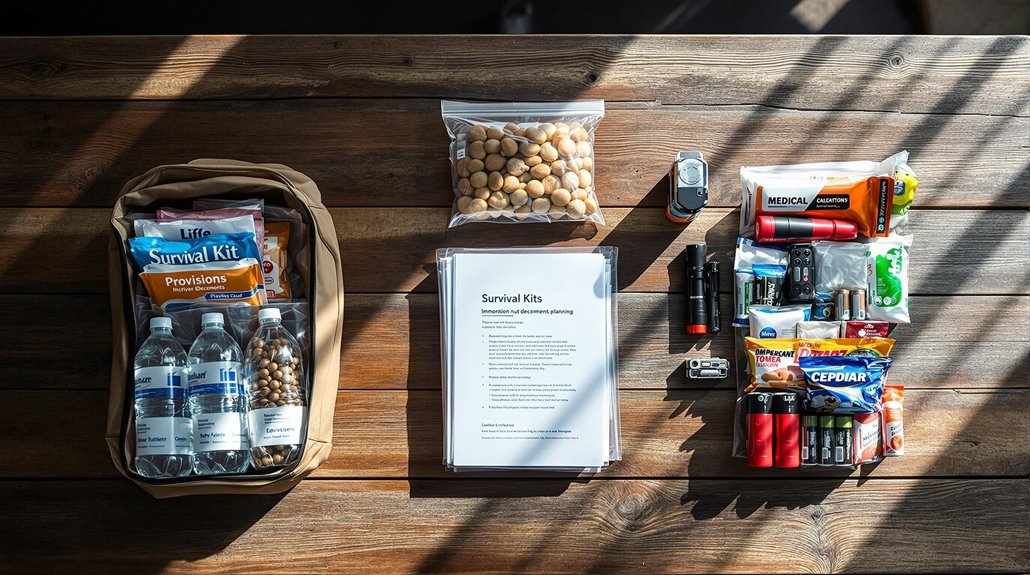What Are the Three P's of Preparedness?

The three P's of preparedness are Planning, Preparing, and Practicing. You'll need to commence with Planning by recognizing risks and developing response strategies. Next, concentrate on Preparing by assembling resources and establishing critical systems. Finally, engage in Practicing through regular drills and simulations to guarantee your plans work effectively. Comprehending these core principles will help safeguard your essential documents and assets when disaster strikes, but there's much more to ponder for thorough readiness.
Understanding the Growing Need for Disaster Readiness
While many organizations focus on day-to-day operations, the growing frequency and severity of disasters demand a shift toward proactive preparedness. In the United States alone, billion-dollar weather disasters and escalating cybercrime threats highlight the urgent need to update outdated emergency plans.
You'll need to take proactive steps before disaster strikes, including developing a thorough action plan and securing essential resources. It's critical to store documents safely and make sure your organization conducts regular drills to test response effectiveness. Working with Group Purchasing Organizations can help guarantee access to indispensable supplies during crises, reducing both recovery time and costs.
Having a detailed communication plan with key contact information for all stakeholders is essential for maintaining operations during emergencies.
Without proper preparation, your organization risks facing severe operational disruptions and financial losses. The growing complexity of modern threats requires moving beyond reactive approaches to embrace strategic, long-term preparedness.
The Rising Costs of Organizational Disasters
As natural and human-made disasters become more frequent, organizations face mounting financial burdens from both direct damages and operational disruptions. You'll find that the costs extend far beyond immediate property damage, encompassing business interruption, lost revenue, and damaged reputation.
When disaster strikes, you're looking at potential expenses like emergency response, temporary relocations, and infrastructure repairs. You'll also need to factor in indirect costs such as decreased productivity, supply chain disruptions, and increased insurance premiums. Studies show that unprepared organizations typically spend 2-3 times more recovering from disasters than those with solid preparedness plans.
The financial impact doesn't stop there - you'll likely face additional expenses for implementing new safety measures, updating emergency protocols, and training staff to prevent future incidents. Historic events like the Johnstown Flood disaster demonstrate how infrastructure failures can result in catastrophic financial losses, with damages reaching millions of dollars even by nineteenth-century standards.
Breaking Down the Three P's Framework
Since effective disaster preparedness hinges on a structured approach, the Three P's blueprint - Planning, Preparing, and Practicing - provides organizations with a clear roadmap for emergency management.
The Three Ps of Disaster framework helps you systematically address potential crises. Planning involves identifying risks, developing response strategies, and creating detailed action plans. You'll need to assess vulnerabilities and establish clear protocols for various emergency scenarios. Preparing focuses on gathering necessary resources, training personnel, and implementing infrastructure to support your plans. This includes securing emergency supplies and establishing communication systems. Guaranteeing your team can execute plans effectively through regular drills, simulations, and updates to procedures based on lessons learned. Together, these components form an inclusive approach that strengthens your organization's resilience against disasters. Understanding the Rule of 3 helps prioritize survival needs when developing emergency protocols, from immediate air requirements to longer-term food considerations.
Building Your Emergency Operations Plan
The foundation of effective disaster response starts with a well-structured Emergency Operations Plan (EOP). Your plan should clearly outline roles, responsibilities, and response procedures for various emergency scenarios. Following best practices, you'll need to identify potential threats, establish communication protocols, and create detailed action steps for each type of emergency.
Make sure you've documented critical contact information, evacuation routes, and resource inventories. You'll want to include specific procedures for different types of emergencies, from natural disasters to technological failures. Remember to review and update your EOP regularly, conduct training sessions, and run practice drills to test its effectiveness. Keep the plan accessible to all team members and guarantee everyone understands their role in implementing it during an actual emergency. Designating multiple meeting places for your team members helps ensure everyone can safely regroup during various emergency scenarios.
Essential Steps for Resource Preparation

Building up your emergency resources requires careful planning and strategic allocation. Start by conducting a thorough inventory of your current supplies and identifying critical gaps in your preparedness. Create a prioritized list of essential items you'll need during severe weather or other emergencies.
Make sure you've got enough food, water, and medical supplies to sustain your household for at least 72 hours. Don't forget to include important documents, cash, and portable charging devices. Store your resources in easily accessible locations and organize them by category for quick retrieval. Review and rotate perishable items regularly to maintain their effectiveness.
Keep a backup supply of prescription medications and maintain an extensive first aid kit. Update your resource cache seasonally and adjust quantities based on your household's changing needs.
Implementing Effective Practice Drills
Regular practice drills form the backbone of emergency preparedness, ensuring your family can respond swiftly when disaster strikes. You'll want to schedule monthly drills that cover various scenarios, from fires to natural disasters, keeping everyone alert and ready.
To create effective rehearsals, start by establishing clear roles for each family member. You should designate meeting points, both inside and outside your home, and practice multiple escape routes. Time your drills and document areas that need improvement.
Make sure you test your emergency equipment during these sessions, including flashlights, fire extinguishers, and communication devices. Don't forget to update your plans based on drill performance and changing circumstances. Remember to involve children in age-appropriate ways, making the drills serious but not scary.
Leveraging Group Purchasing Organizations

Many savvy preppers maximize their purchasing power by joining group purchasing organizations (GPOs), which pool resources to secure bulk discounts on essential supplies. You'll find that GPOs negotiate better prices for emergency food, medical supplies, and survival gear than you could obtain individually.
The group buying advantages extend beyond cost savings. You'll connect with like-minded individuals who share valuable information about product quality and vendor reliability. These organizations often provide access to exclusive deals, bulk ordering opportunities, and sometimes even training resources. When you join a GPO, you'll also benefit from their established relationships with manufacturers and distributors, ensuring you receive authentic products rather than counterfeits. Consider researching local prepper groups or online communities that offer group purchasing programs to stretch your preparedness budget further.
Securing Critical Documents and Assets
Have you ever considered how quickly you'd need to evacuate with your essential documents during an emergency? Paperwork protection isn't just about keeping documents safe—it's about ensuring your recovery after a crisis. You'll need quick access to pivotal records that prove your identity, ownership, and insurance coverage.
Create a system to safeguard your indispensable documents:
- Store digital copies of important papers in an encrypted cloud storage service
- Keep original documents in a waterproof, fireproof safe or safety deposit box
- Maintain an organized filing system with clearly labeled folders for quick retrieval
- Create an emergency document checklist including passports, deeds, birth certificates, and insurance policies
Don't wait until disaster strikes to organize your critical paperwork. A well-planned document management system can make a significant difference in your recovery process.




